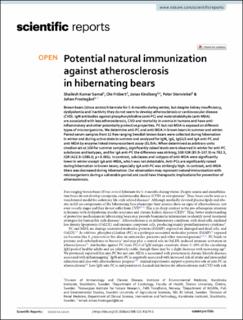Potential natural immunization against atherosclerosis in hibernating bears
Peer reviewed, Journal article
Published version

Åpne
Permanent lenke
https://hdl.handle.net/11250/2759886Utgivelsesdato
2021Metadata
Vis full innførselSamlinger
- Publikasjoner fra CRIStin - NINA [2364]
- Scientific publications [1392]
Originalversjon
10.1038/s41598/s41598-021-91679-1Sammendrag
Brown bears (Ursus arctos) hibernate for 5–6 months during winter, but despite kidney insufciency, dyslipidemia and inactivity they do not seem to develop atherosclerosis or cardiovascular disease (CVD). IgM antibodies against phosphorylcholine (anti-PC) and malondialdehyde (anti-MDA) are associated with less atherosclerosis, CVD and mortality in uremia in humans and have antiinfammatory and other potentially protective properties. PC but not MDA is exposed on diferent types of microorganisms. We determine anti-PC and anti-MDA in brown bears in summer and winter. Paired serum samples from 12 free ranging Swedish brown bears were collected during hibernation in winter and during active state in summer and analyzed for IgM, IgG, IgG1/2 and IgA anti-PC and anti-MDA by enzyme linked immunosorbent assay (ELISA). When determined as arbitrary units (median set at 100 for summer samples), signifcantly raised levels were observed in winter for anti-PC subclasses and isotypes, and for IgA anti-PC the diference was striking; 100 IQR (85.9–107.9) vs 782.3, IQR (422.8–1586.0; p < 0.001). In contrast, subclasses and isotypes of anti-MDA were signifcantly lower in winter except IgA anti-MDA, which was not detectable. Anti-PCs are signifcantly raised during hibernation in brown bears; especially IgA anti-PC was strikingly high. In contrast, anti-MDA titers was decreased during hibernation. Our observation may represent natural immunization with microorganisms during a vulnerable period and could have therapeutic implications for prevention of atherosclerosis.
